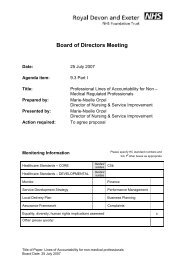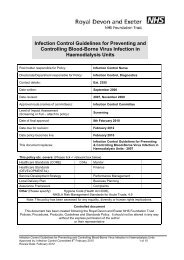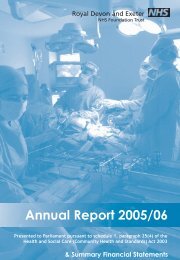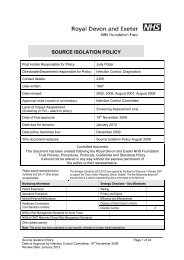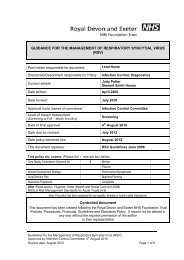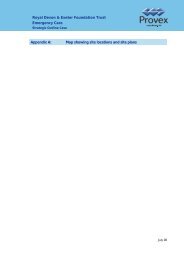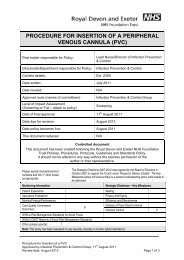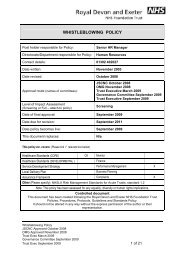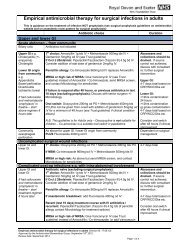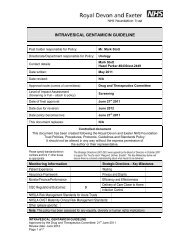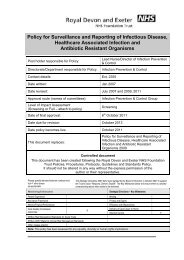Annual Report and Accounts 2012/13 - Royal Devon & Exeter Hospital
Annual Report and Accounts 2012/13 - Royal Devon & Exeter Hospital
Annual Report and Accounts 2012/13 - Royal Devon & Exeter Hospital
You also want an ePaper? Increase the reach of your titles
YUMPU automatically turns print PDFs into web optimized ePapers that Google loves.
98 4. Our Governance<br />
<strong>Royal</strong> <strong>Devon</strong> <strong>and</strong> <strong>Exeter</strong> NHS Foundation Trust<br />
<strong>Annual</strong> <strong>Report</strong> <strong>and</strong> <strong>Accounts</strong> <strong>2012</strong>/<strong>13</strong><br />
Quality Governance <strong>Report</strong>ing<br />
We have put in place a rigorous<br />
approach to governing the quality<br />
of our services. More details about<br />
these arrangements are included in<br />
our Quality <strong>Report</strong> (see page 58) –<br />
which is a sub-section within the main<br />
<strong>Annual</strong> <strong>Report</strong> as well as in the <strong>Annual</strong><br />
Governance Statement (see page 88).<br />
There are no material inconsistencies<br />
between the <strong>Annual</strong> Governance<br />
Statement, Board statements required<br />
by the Compliance Framework, the<br />
Quality <strong>Report</strong> <strong>and</strong> <strong>Annual</strong> <strong>Report</strong>. The<br />
Board, through its sub-committees,<br />
regularly reviews the effectiveness of<br />
the Trust's system of internal controls.<br />
Board Assurance Framework<br />
The Board Assurance Framework (BAF)<br />
is a Board-owned document whose<br />
primary role is to inform the Board<br />
about the totality of risks or obstacles<br />
that may impede it from achieving<br />
its strategic objectives as outlined<br />
in the Trust’s long-term Strategy<br />
document. The BAF also provides<br />
assurances that adequate controls<br />
are operating to reduce these risks to<br />
acceptable levels. Over the past twelve<br />
to eighteen months the BAF has been<br />
on an evolutionary journey, in parallel<br />
with the redevelopment of the wider<br />
governance arrangements within the<br />
Trust. A review of the BAF by Internal<br />
Audit, undertaken in March 20<strong>13</strong>,<br />
has declared: ‘Overall we are of the<br />
opinion that the redesigned BAF is fit<br />
for purpose’. Since that opinion, some<br />
further work has been undertaken to<br />
enhance the working of the BAF <strong>and</strong><br />
to ensure it remains a living document<br />
which informs the Board agenda.<br />
Regulatory ratings/CQC reports<br />
<strong>and</strong> response<br />
Monitor assesses the performance<br />
of the Trust using Key Performance<br />
Indicators, designated as<br />
Regulatory Ratings. There are two<br />
ratings:<br />
• Financial Risk Rating assessed on a<br />
scale from 1 (high risk) to 5<br />
(low risk).<br />
• Governance assessed on a scale of<br />
green/amber-green/amber-red.<br />
Deriving the financial risk rating<br />
The financial risk rating is weighted<br />
average of financial criteria scores,<br />
which are:<br />
• Achievement of plan<br />
• Underlying performance<br />
• Financial efficiency<br />
• Liquidity<br />
Deriving the governance risk<br />
rating<br />
Monitor includes the following<br />
elements within the governance<br />
risk rating:<br />
• Service performance<br />
• Third party reports<br />
• Failures to comply with board<br />
statements<br />
• <strong>Annual</strong> Plan



